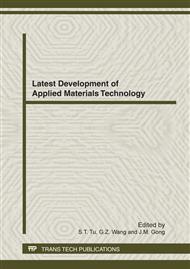p.125
p.132
p.135
p.138
p.147
p.150
p.152
p.156
p.161
Preparation of Spray Pyrolyzed Bismuth Oxide and its Application in Inhibition of Ultraviolet from Light-Emitting Diode (LED)
Abstract:
In the present study, bismuth oxide (Bi2O3) powders were prepared from bismuth nitrate at various temperatures by spray pyrolysis (SP). The Bi2O3 powder can convert from a monoclinic α phase to a tetragonal β phase at a pyrolysis temperature of > 600° C. The crystallinity of the SP powder increased with the increase of pyrolysis temperature. The resulting SP powders were then mixed with organics and screen-printed onto the surface of LED for the evaluation of ultraviolet (UV) inhibition. The β-type bismuth oxide powder pyrolyzed at 700°C exhibited a fine crystal structure. This caused the efficiency of UV inhibition to be 97.71% when the powder concentration was as low as 9.04 wt%.
Info:
Periodical:
Pages:
147-149
Citation:
Online since:
April 2012
Price:
Сopyright:
© 2012 Trans Tech Publications Ltd. All Rights Reserved
Share:
Citation:


